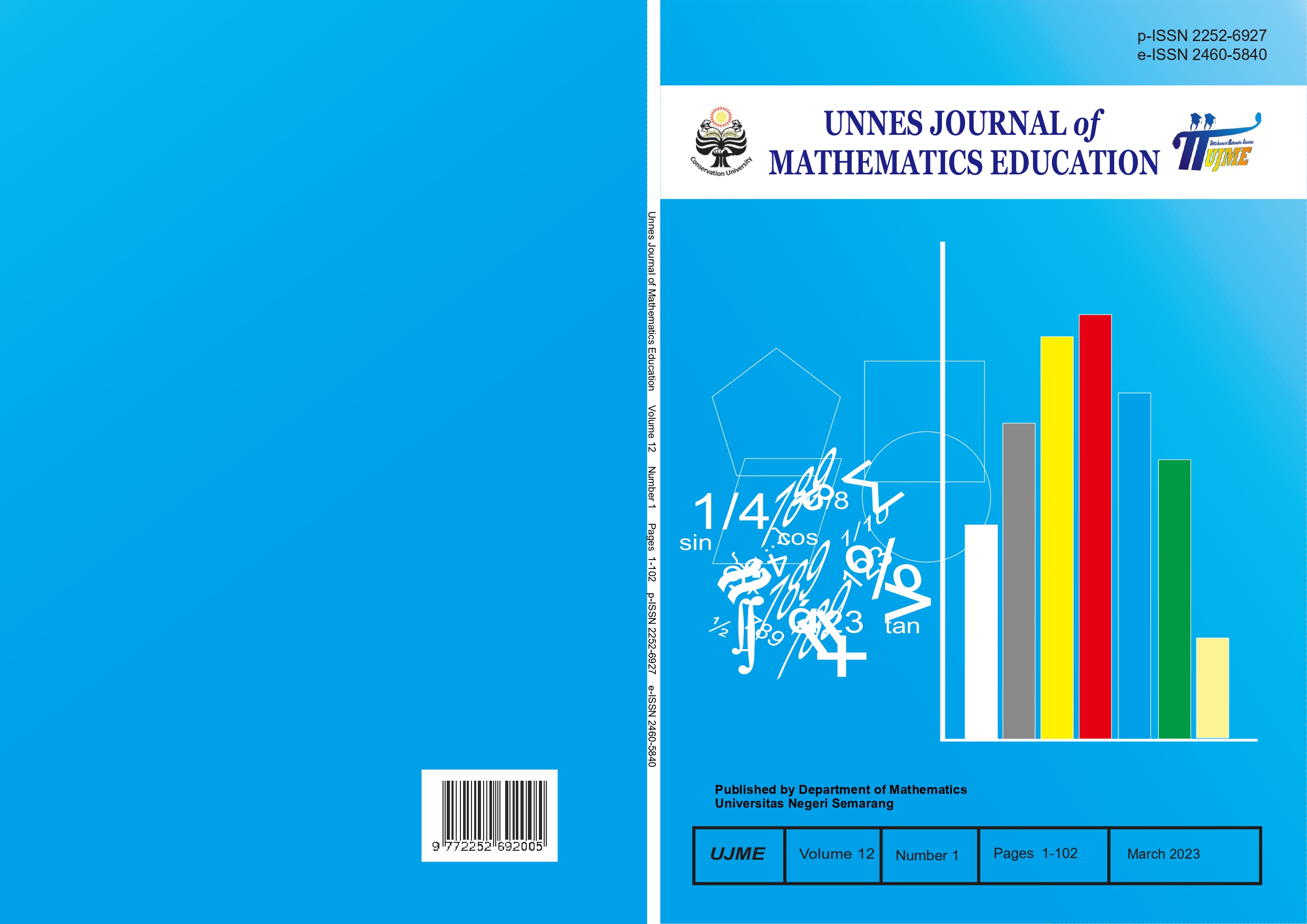Mathematical Creative Thinking Ability Viewed by Adversity Quotient in Problem-Based Learning Integrated STEM
##plugins.themes.academic_pro.article.main##
Abstract
The purposes of this study were (1) to know the average test results of students' mathematical creative thinking abilities with the Problem-Based Learning integrated STEM to achieve the standard of minimum completeness of mastery learning and classical mastery; (2) to find out students' creative thinking abilities with Problem-Based Learning integrated STEM is better than students' creative thinking abilities with Discovery Learning models; (3) to find out students' mathematical creative thinking ability increase in Problem-Based Learning integrated STEM; and (4) to determine and describe the effect of Adversity Quotient on students' mathematical creative thinking ability in the Problem-Based Learning integrated STEM. The method used was a mixed method with a sequential explanatory design. In this research, 6 research subjects were taken based on the level of Adversity Quotient in the experimental class. Research results show that (1) the average test results for students' mathematical creative thinking ability using the Problem-Based Learning integrated STEM achieved the standard of minimum completeness of mastery learning and classical mastery; (2) students' creative thinking abilities with the Problem-Based Learning integrated STEM are better than students' creative thinking abilities with Discovery Learning models; (3) there was an increase in students' mathematical creative thinking skills in the Problem-Based Learning integrated STEM model; (4) there is an influence of the Adversity Quotient on students' mathematical creative thinking abilities in the Problem-Based Learning integrated STEM; S-1, S-2, S-3, S-4, and S-5 are not yet able to fulfill the four indicators of mathematical creative thinking ability, and S-6 fulfills the four indicators of mathematical creative thinking ability
##plugins.themes.academic_pro.article.details##
References
Dewi, W. I., & Harjono, N. (2021). Efektivitas Model Pembelajaran Problem Solving dan Problem Based Learning (PBL) Ditinjau dari Kemampuan Berpikir Kreatif Matematis Siswa Kelas 5 Sekolah Dasar. Jurnal Cendekia : Jurnal Pendidikan Matematika, 5(3), 2678–2689. https://doi.org/10.31004/cendekia.v5i3.943
Florida, R., Mellander, C., & KIng, K. (2015). The Global Creativity Indeks 2015. 1–64.
Jauhariyyah, F. R., Suwono, H., & Ibrohim. (2017). Science, Technology, Engineering and Mathematics Project Based Learning (STEM-PjBL) pada Pembelajaran Sains. Prosiding Seminar Pendidikan IPA Pascasarjana UM, 2, 432–436.
Leonard, & Amanah, N. (2014). Pengaruh Adversity Quotient (AQ) dan Kemampuan Berpikir Kritis terhadap Prestasi Belajar Matematika. Perspektif Ilmu Pendidikan, 28(1), 55–64.
Mardhiyah, R. H., Aldriani, S. N. F., Chitta, F., & Zulfikar, M. R. (2021). Pentingnya Keterampilan Belajar di Abad 21 sebagai Tuntutan dalam Pengembangan Sumber Daya Manusia. Jurnal Pendidikan, 12(1), 29–40. https://kns.cnki.net/kcms/detail/11.1991.n.20210906.1730.014.html
Masitoh, S., & Agoestanto, A. (2020). Kemampuan Berpikir Kreatif Matematis Ditinjau dari Minat Belajar dan AQ Siswa Melalui Model Pembelajaran Creative Problem Solving. 2008.
Nurjanah, S., Sarah, S., & Zanthy, L. S. (2019). Analisis Kemampuan Berpikir Kreatif Matematis Dan Minat Belajar Siswa MTS. Journal on Education, 1(3), 260–266.
PISA, O. (2019). PISA 2018 Assessment and Analytical Framework. In OECD Publishing. https://doi.org/10.1787/b25efab8-en
Rahmah, N. (2018). Hakikat Pendidikan Matematika. Al-Khwarizmi: Jurnal Pendidikan Matematika Dan Ilmu Pengetahuan Alam, 1(2), 1–10. https://doi.org/10.24256/jpmipa.v1i2.88
Rizqi, M., Suyitno, H., & Dwijanto. (2019). Efektivitas pembelajaran berbasis masalah dalam meningkatkan kemampuan berpikir kreatif matematis siswa mts islamic center cirebon. 300–305.
Sari, D. N. K., & Masrukan. (2022). Penerapan Asesmen Berbasis Socrative untuk Mengukur Kemampuan Berpikir Kreatif Matematis dengan Model Problem Based Learning Ditinjau dari Rasa Ingin Tahu. UJME.
Sumartini, T. S. (2019). Kemampuan Berpikir Kreatif Mahasiswa melalui Pembelajaran Mood , Understanding , Recall , Detect , Elaborate , and Review Mosharafa : Jurnal Pendidikan Matematika Mosharafa : Jurnal Pendidikan Matematika. Mosharafa: Jurnal Pendidikan Matematika, 8(1), 13–24.
Vistara, M. F., Asikin, M., Ardiansyah, A. S., & Pudjiastut, E. (2022). Problem Based Learning Berorientasi STEM Context terhadap Kemampuan Berpikir Kreatif Matematika Siswa. Prosiding Seminar Nasional Matematika (PRISMA), 5, 451–460. https://journal.unnes.ac.id/sju/index.php/prisma/article/view/54564
Widi Trisna Putri, M., & Ratu, N. (2018). Analisis Tingkat Berpikir Kreatif Siswa Dalam Menyelesaikan Soal Luas Gabungan Pada Materi Bangun Datar Di Smp Negeri 8 Salatiga Kelas Vii. Pendekar : Jurnal Pendidikan Berkarakter, 1(1), 103. https://doi.org/10.31764/pendekar.v1i1.298
Widowati, C., Purwanto, A., & Akbar, Z. (2021). Problem-Based Learning Integration in Stem Education to Improve Environmental Literation. International Journal of Multicultural and Multireligious Understanding, 8(7), 374. https://doi.org/10.18415/ijmmu.v8i7.2836
Winoto, Y. C., & Prasetyo, T. (2020). Efektivitas Model Pembelajaran Problem Solving dan Discovery Learning Terhadap Kemampuan Berpikir Kritis Siswa Sekolah Dasar. Jurnal Basicedu, 4(2), 361–370. https://doi.org/10.31004/basicedu.v4i2.358
